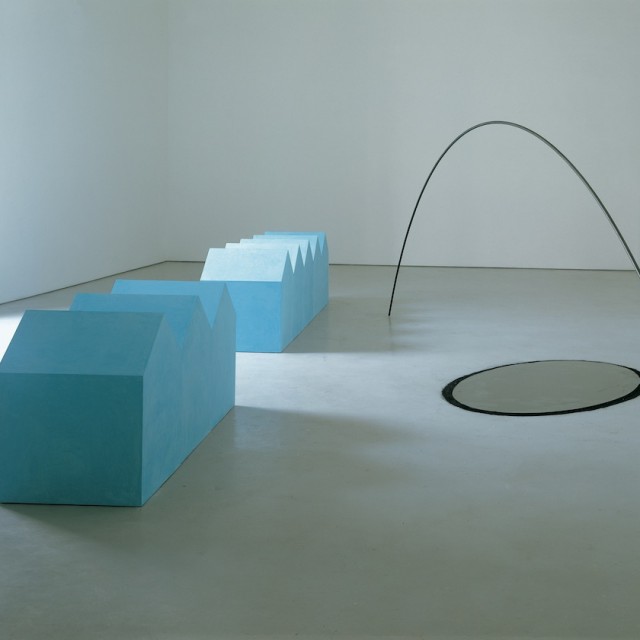Un giorno così bianco, così bianco (So white a day ) marks the culmination of a project uniting three museums, the Madre in Naples, the MAXXI in Rome and the GAM in Turin: a single title for three exhibitions that explore the variety and depth of the artistic practice of Ettore Spalletti, who over forty years has traversed the most significant phases of the history of international art, developing an original language capable of creating a dialogue between modernity and classicism, painting, sculpture and architecture.
This threefold exhibition is the artist’s most complete retrospective, a project that can rightfully be termed, in its institutional plurality, as “republican.” Each exhibition is independent, conceived by the artist in dialogue with the exhibition spaces of the various museums, but also as a chapter of a story that unites the different landscapes of our country or, as the artist himself states, its different “lights.”
The exhibition at the Madre presents an articulated excursus of both historical and recent works, retracing the artist’s research from its beginnings in the sixties to the present, uniting painting, sculpture, environmental installations, books, and projects. The exhibition layout eschews a chronological order, instead seeking to bring out the relations between works from different periods. Devised by the artist for the ancient spaces of Palazzo Donnaregina, the exhibition reflects a central theme of Spalletti’s whole production, namely the effacement of time as linearity and progression, and its exploration as eternal present, distilled into individual works. In working against and beyond the idea of time, what emerges as unified fact is the recurrence of forms, colors and materials that Spalletti has always used, enhancing the specific expressive capacity of each.
The exhibition layout alternates works never shown to the public before with others that represent key moments in the artist’s career. The central motifs of Spalletti’s art are all present: the relation between the natural datum and abstract language, the relation between painting and sculpture as the articulation of color and of volumes in space, the memory of the classical combined with modernity, the centrality of the experience of landscape and the exploration of monochromy as a metaphor for perceptual sensibility.
The almost musical alternation of materials – such as alabaster, marble, onyx, gold leaf, metals, precious stones, paper and pure pigment, all featured in the show – configure the exhibition as a journey within the aesthetic, symbolic and expressive potential of the materials themselves, which the artist explores in their purity, as chromatic and perceptual “solids” capable of opening up the horizons of painting.
The central element, finally, is light, its subtle yet continuous variations which impacts on the works and the rooms, fusing the museum with its context. The architecture of the Madre becomes part of the exhibition, with the cadenced layout of the rooms, the windows opening onto the alleys in the neighborhood of San Lorenzo, the church of Donnaregina Vecchia, the hills of Capodimonte and Castel Sant’Elmo, glimpses of the sea and Vesuvius in the distance. Perhaps it is possible, thinking of the intellectual, physical and spiritual concentration of this exhibition, to evoke the effect on visitors of strolling through the cells of the monastery of San Marco in Florence, decorated with fresco-prayers by Beato Angelico.
Ettore Spalletti has exhibited in major museums worldwide, in both group and personal exhibitions. He represented Italy at the 1997 Venice Biennale and took part in three other editions, in 1982, 1993 and 1995. He has participated in two editions of Documenta in Kassel, in 1982 and 1993. His solo exhibitions have been presented at the Museum Folkwang in Essen (1982), the Museum Van Hedendaagse Kunst di Gent (1983), the Halle d’art contemporain di Rennes (1988), De Appel Art Center, Amsterdam, the Kunstverein München, and the Portikus Frankfurt (1989), the Musée d’Art Moderne de la Ville de Paris (1991), the IVAM – Centre del Carme in Valencia (1992), the Solomon R. Guggenheim Museum in New York (1993), the MUHKA in Antwerp (1995), the Musée d’Art Moderne e Contemporain de Strasbourg (1998), the Museo di Capodimonte in Naples (1999), the Fundación “la Caixa” in Madrid (2000), the Henry Moore Institute in Leeds (2005), the Academy of France-Villa Medici in Rome (2006), the Museum Kurhaus in Kleve (2009) and the Galleria Nazionale d’Arte Moderna in Rome (2010).
